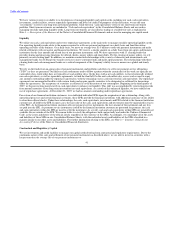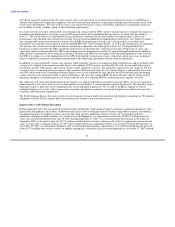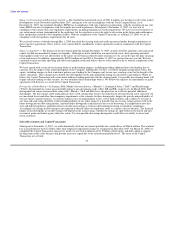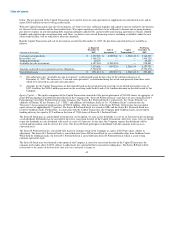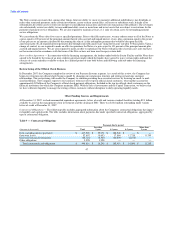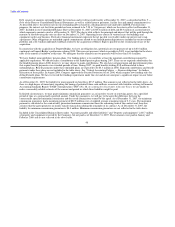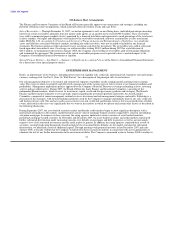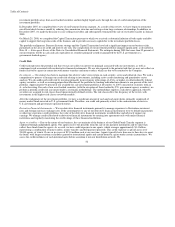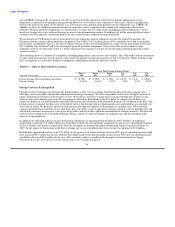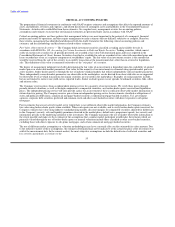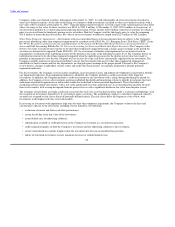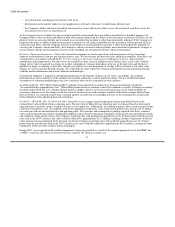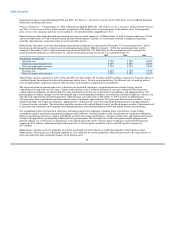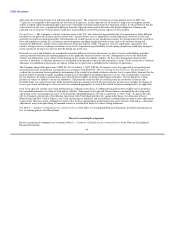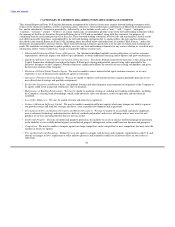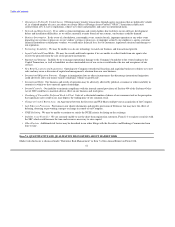MoneyGram 2007 Annual Report Download - page 54
Download and view the complete annual report
Please find page 54 of the 2007 MoneyGram annual report below. You can navigate through the pages in the report by either clicking on the pages listed below, or by using the keyword search tool below to find specific information within the annual report.
Table of Contents
Off-Balance Sheet Arrangements
The Finance and Investment Committee of the Board of Directors generally approves any transactions and strategies, including any
potential off-balance sheet arrangements, which materially affect investment results and cash flows.
Sale of Receivables — Through December 31, 2007, we had an agreement to sell, on an offering basis, undivided percentage ownership
interests in certain receivables, primarily from our money order agents, in an amount not to exceed $400.0 million. These receivables
were sold to commercial paper conduits (trusts) sponsored by a financial institution and represented a small percentage of the total assets
in these conduits. Our rights and obligations were limited to the receivables transferred, and were accounted for as sales transactions
under SFAS No. 140, Accounting for Transfers and Servicing of Financial Assets and Extinguishments of Liabilities. As a result, the
assets and liabilities associated with these conduits, including our sold receivables, were not recorded or included in our financial
statements. The business purpose of this agreement was to accelerate cash flow for investment. The receivables were sold at a discount
based upon short-term interest rates. On average we sold receivables totaling $349.9 million during 2007 for a total discount of
$20.3 million. At management's discretion in January 2008, the Company ceased selling its receivables, paid all remaining obligations
and terminated the agreement. The termination of the sale of receivables programs is not expected to have a material impact to the
Company's Consolidated Financial Statements or liquidity.
Special Purpose Entities — See Note 2 — Summary of Significant Accounting Policies of the Notes to Consolidated Financial Statements
for a discussion of our special purpose entities.
ENTERPRISE RISK MANAGEMENT
Risk is an inherent part of our business, including interest rate risk, liquidity risk, credit risk, operational risk, regulatory risk and foreign
currency exchange risk. See Part 1, Item 1A "Risk Factors" for a description of the principal risks to our business.
Our risk management objective is to monitor and control risk exposures to produce steady earnings growth and long-term economic
value. The extent to which we properly and effectively manage each of the various types of risk is critical to our financial condition and
profitability. Management implements policies approved by the Company's Board of Directors covering our funding activity, investing
activity and use of derivatives. During 2007, the Board of Directors had a Finance and Investment Committee, consisting of five
independent Board members, which oversaw its investment, capital, credit and foreign currency policies and strategies. The Board's
Finance and Investment Committee receives periodic reports regarding the investment portfolio and results. An Asset/Liability
Committee, comprised of senior management, routinely reviews investment and risk management strategies and results. Following is a
discussion of the strategies, with forward-looking statements, used by the Company to manage and mitigate interest rate risk, credit risk
and foreign currency risk. The analyses used to assess interest rate risk, credit risk and foreign currency risk are not predictions of future
events, and actual results may vary significantly due to events in the markets in which we operate and certain other factors as described in
the following discussions.
During September 2007, the asset-backed securities market and broader credit markets began to show significant disruption, with a
general lack of liquidity in the markets and deterioration in fair value of mortgage-backed securities triggered by concerns surrounding
sub-prime mortgages. In response to these concerns, the rating agencies undertook extensive reviews of asset-backed securities,
particularly mortgage-backed securities. In November and December 2007, the asset-backed securities and credit markets experienced
further substantial deterioration under increasing concerns over defaults on mortgages and debt in general, as well as an increasingly
negative view of all structured investments and the credit market in general. In addition, the rating agencies continued their review of
securities, issuing broad rating downgrades based on high levels of assumed future defaults. As the market continued its substantial
deterioration, we identified a need for additional capital. Through meetings with potential investors in late December 2007 and early
January 2008, it became evident that the Company would need to divest certain investments in connection with any recapitalization to
eliminate the risk of any further deterioration in the investment portfolio. The Company commenced a plan in January 2008 to realign its
51


